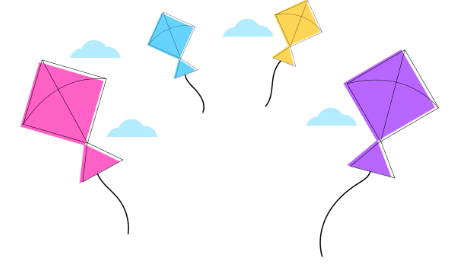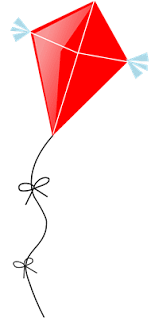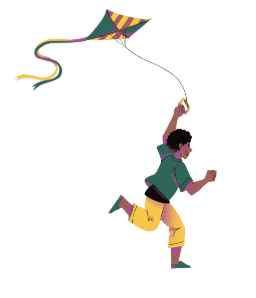Short and Long Question Answers: The Kites | Short & Long Answer Questions for Class 6 PDF Download
Short Answer Type Questions
Q1: What does the poet mean by describing the kites as "coloured birds"?
Ans: The poet compares the kites to "coloured birds" to emphasize their vibrant and dynamic movement in the sky. Like birds, kites soar, flutter, and create a lively spectacle. This comparison helps the reader visualize the kites' colorful appearance and graceful movement, as if they were alive, mirroring the freedom and energy of birds flying in the sky.
Q2: How does the poet express the child's desire to fly like a kite?
Ans: The child expresses a longing to be light and free, wishing to ride on a kite and soar through the sky. By saying, "I wish I were small and light as air," the child symbolizes a desire for adventure and freedom. The idea of flying on a kite represents an escape into a world where the boundaries of earth do not limit the child.
Q3: What role does imagination play in the poem?
Ans: Imagination plays a central role in the poem as the child envisions flying on a kite. The child imagines being light, drifting on paper wings, and experiencing the world from above. This imaginative journey allows the poet to convey the thrill and freedom of flying, creating a sense of wonder and possibility, and emphasizing the power of imagination to transcend everyday life.
Q4: What is the significance of the line "The people below would stand and stare"?
Ans: This line highlights the awe and admiration others feel when they see the child flying high in the sky. The people below are intrigued and wish they could experience the same freedom. It emphasizes the contrast between the child’s carefree experience and the limitations of those on the ground, showcasing the child’s sense of wonder.
Q5: What does the phrase "paper wings" symbolize in the poem?
Ans: The phrase "paper wings" symbolizes the delicate and light nature of the kite. It suggests that despite being made of paper, the kite can soar through the air, representing freedom and lightness. The paper wings embody the child’s desire to escape from the weight of the world and experience the joy of flying.
Q6: How does the poet use the theme of freedom in the poem?
Ans: The theme of freedom is expressed through the child’s wish to fly like a kite. The child imagines being liberated from the constraints of the earth, soaring high and experiencing the world from a new perspective. The kite’s flight symbolizes a sense of liberation and joy, capturing the idea that freedom is about escaping boundaries and embracing adventure.
Q7: What is the emotional tone of the poem?
Ans: The tone of the poem is one of excitement, freedom, and longing. The child expresses a desire to experience the thrill of flying on a kite and explore the world from a different perspective. The tone reflects the joy of freedom, imagination, and the wonder of seeing the world from above, free from everyday constraints.
Long Answer Type Questions
Q1: Explain the significance of the child’s desire to be light as air and ride a kite.
Ans: The child’s wish to be light as air and ride on a kite symbolizes their longing for freedom and adventure. By desiring to be light, the child imagines escaping the limitations of daily life and experiencing boundless possibilities. The kite, made of delicate paper, represents the child’s wish to see the world from a free perspective, unburdened by gravity and responsibilities. This desire for flight mirrors the joy and excitement of childhood, where imagination knows no limits. The wish also reflects the child’s yearning for freedom and exploration, offering a sense of liberation from the usual constraints of life. The kite’s flight symbolizes the child’s dreams of adventure and purity, showing how childhood dreams encourage boundless exploration and a desire for new experiences.
Q2: Discuss the use of personification in the poem.
Ans: The poet uses personification to give human qualities to inanimate objects, enhancing the emotional connection in the poem. One example is “hear the songs that the wild wind sings,” where the wind is described as singing, a human action. This gives the wind a voice, making it an active part of the child’s journey. The wild wind, representing energy and freedom, accompanies the kite as it soars, adding excitement. Another instance of personification is describing the kite as “drifting upon paper wings.” The kite is given the human ability to drift gracefully, as if it has its own will. By personifying both the wind and the kite, the poet brings them to life, making the environment feel alive and participatory, emphasizing the freedom and adventure the child experiences.
Q3: How does the child’s perspective of the world change when imagining flying on a kite?
Ans: When the child imagines flying on a kite, their perspective shifts dramatically. From the ground, the child's view is limited, but in the sky, they envision seeing the park and rooftops, offering a sense of freedom and excitement. This change symbolizes liberation from earthly constraints and a fresh perspective on the world. The imagined flight represents the idea of growth and expanding one’s views. As the child rises, they see the world from a broader and more exhilarating angle, where everything seems smaller but full of possibilities. The shift reflects how imagination can help one transcend limitations and find new opportunities. The kite’s flight symbolizes the child’s wish for freedom and the joy of exploring new experiences, showcasing how changing perspectives can open up new insights and possibilities.
FAQs on Short and Long Question Answers: The Kites - Short & Long Answer Questions for Class 6
| 1. What are the main themes presented in the story "The Kites"? |  |
| 2. How does the author describe the experience of flying kites in "The Kites"? |  |
| 3. What role does friendship play in "The Kites"? |  |
| 4. What lessons can readers learn from "The Kites"? |  |
| 5. How does the setting influence the events in "The Kites"? |  |
















